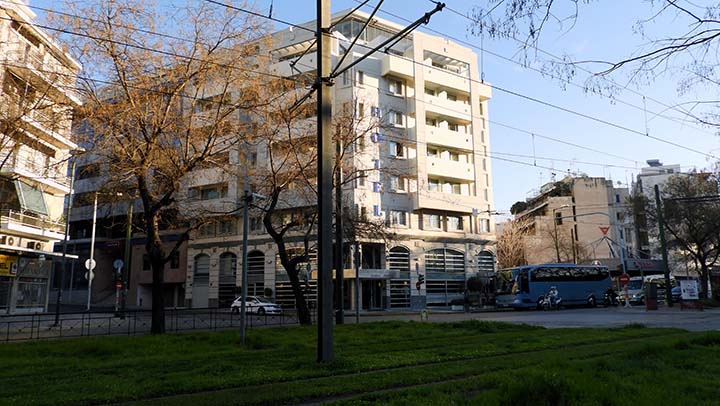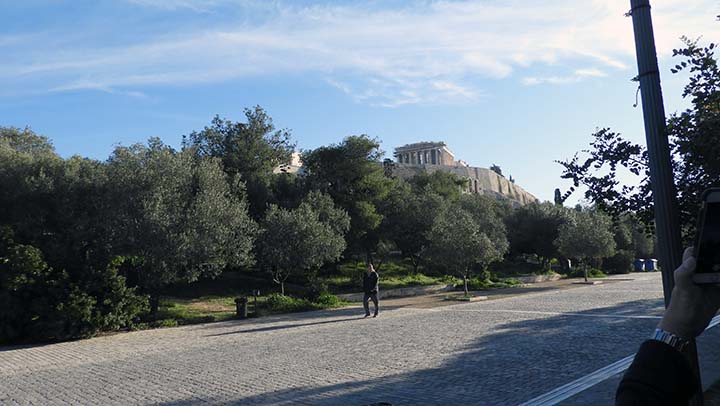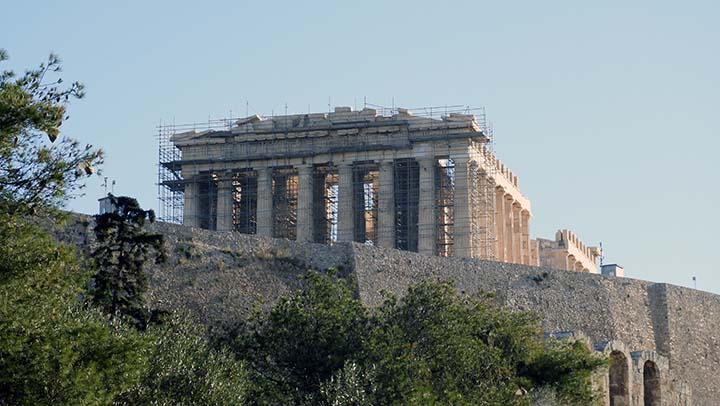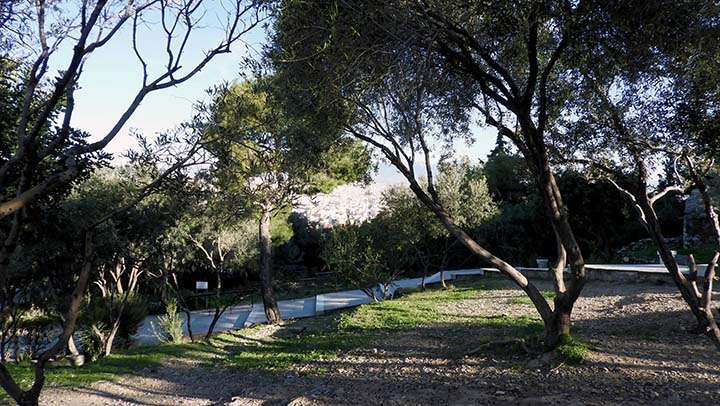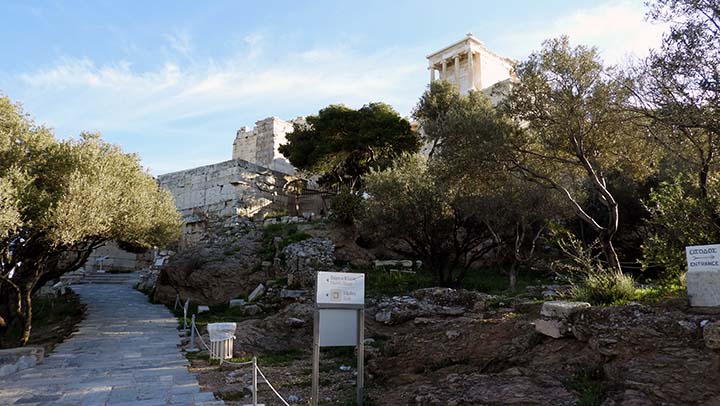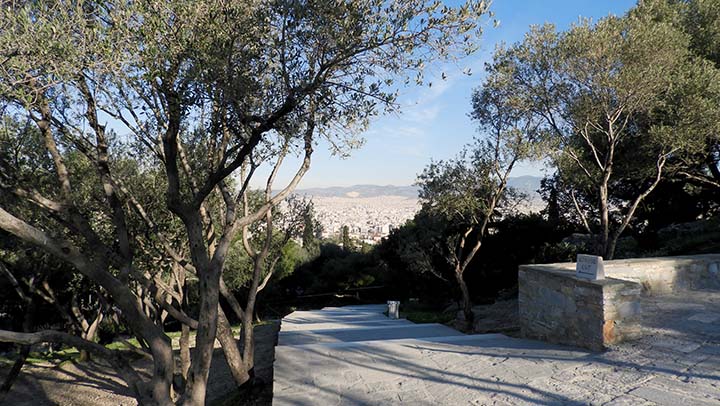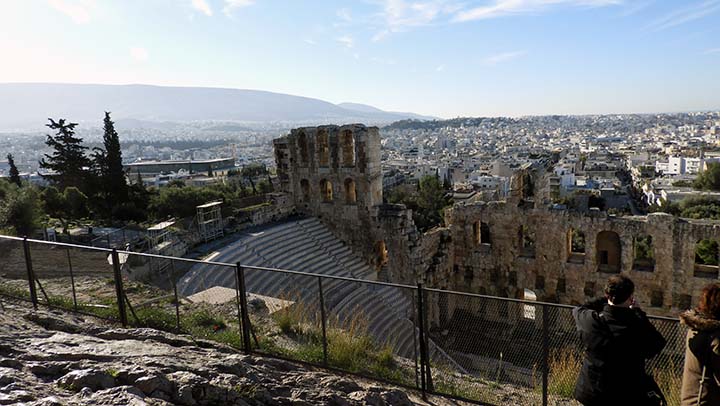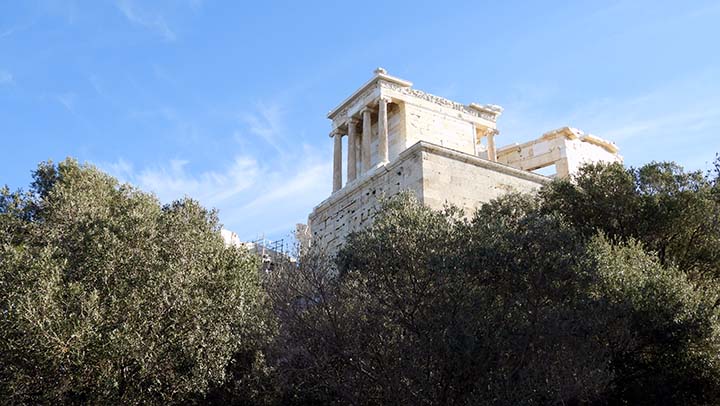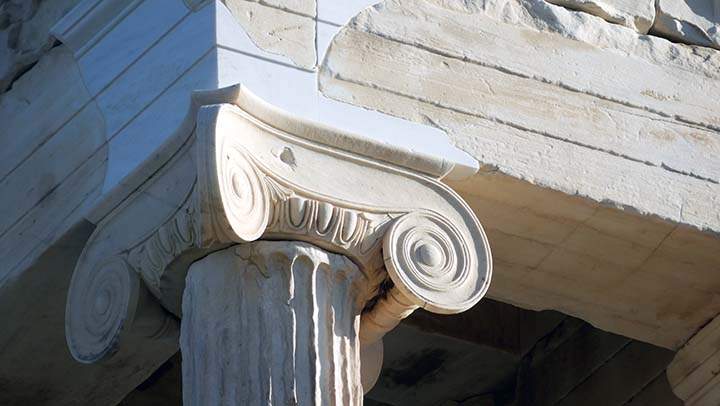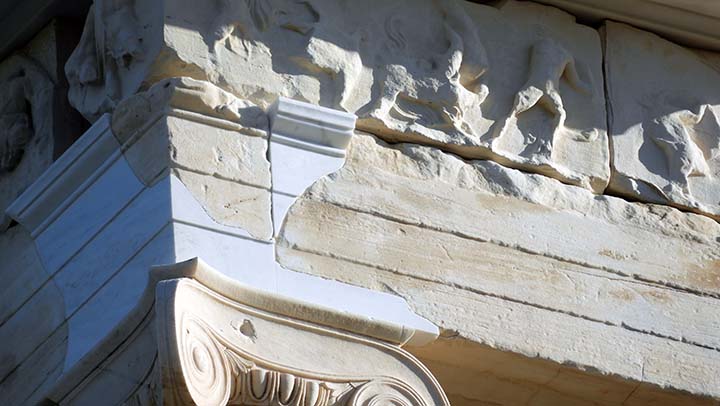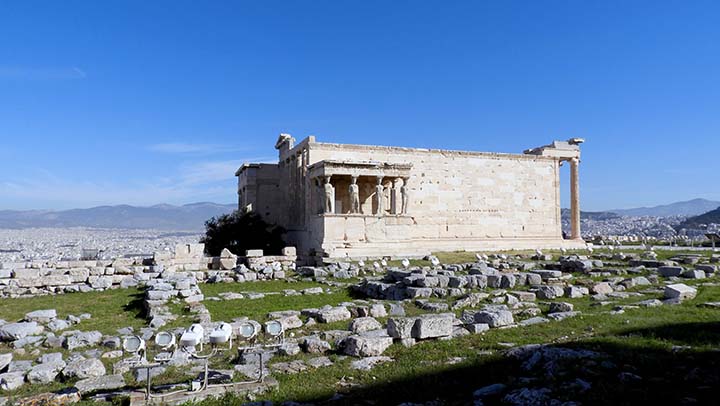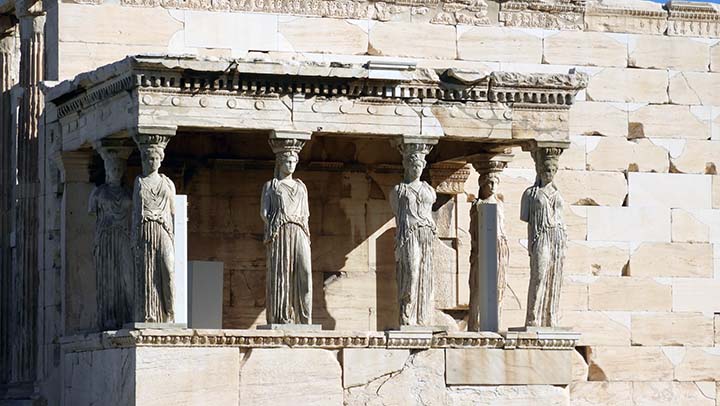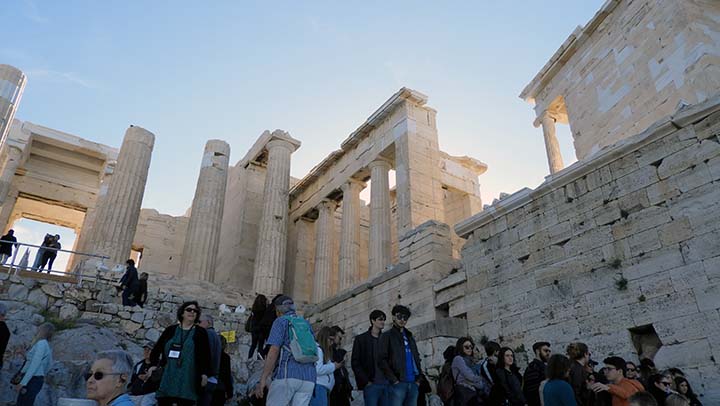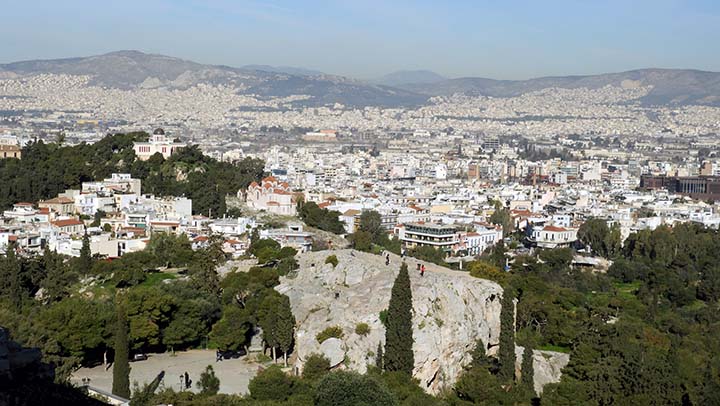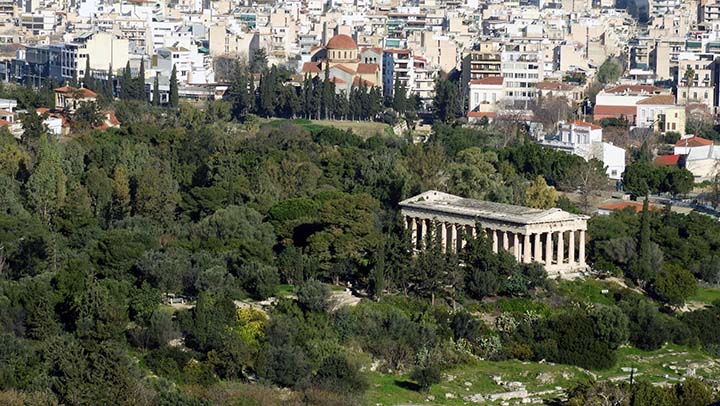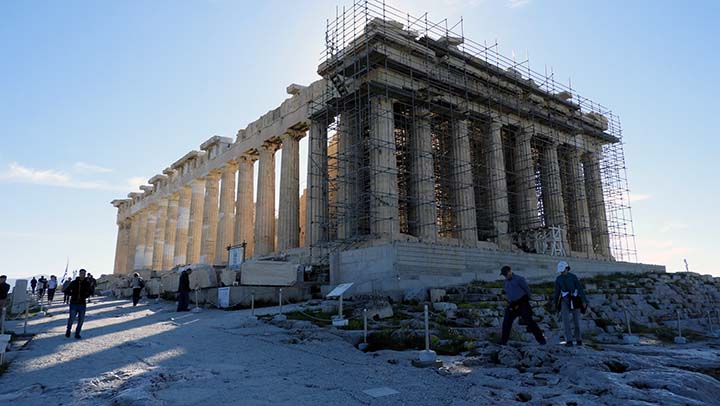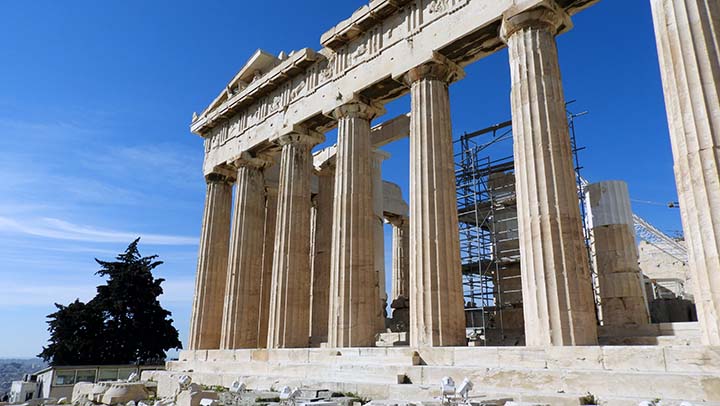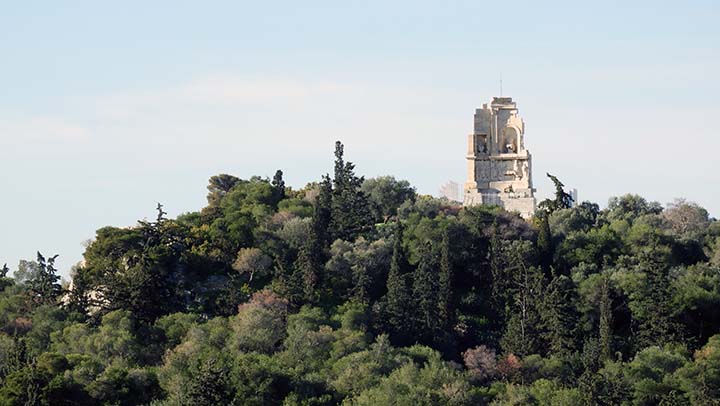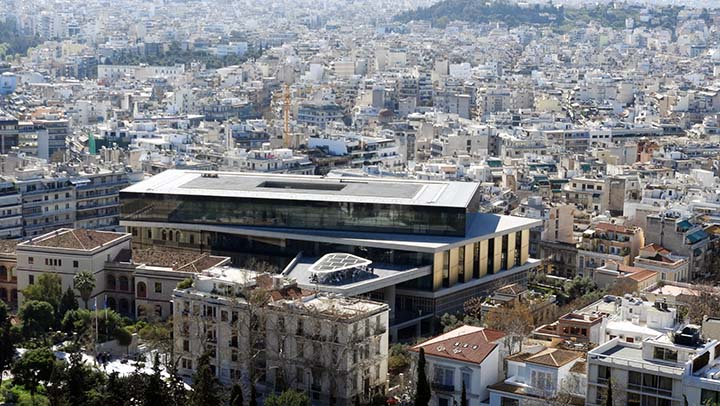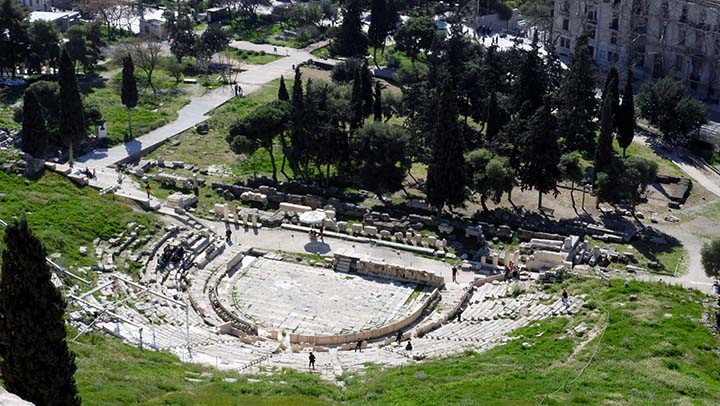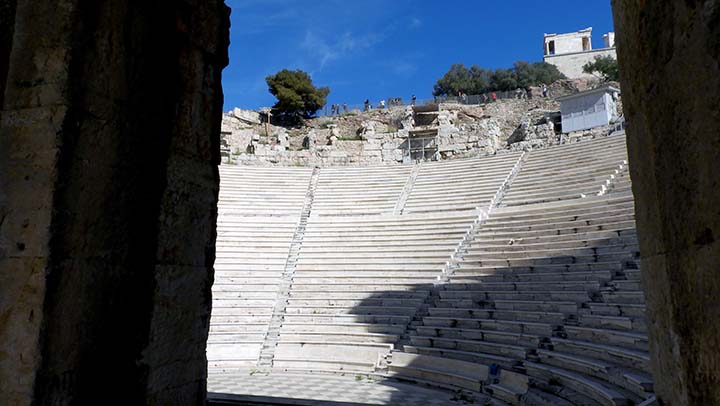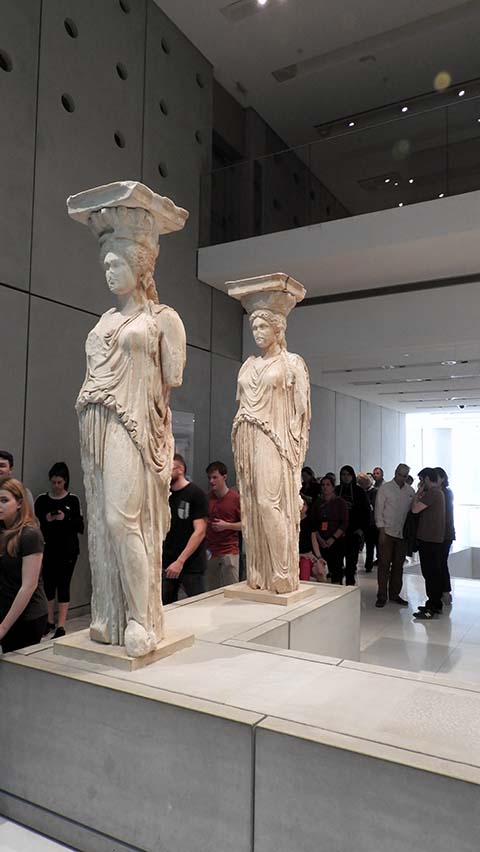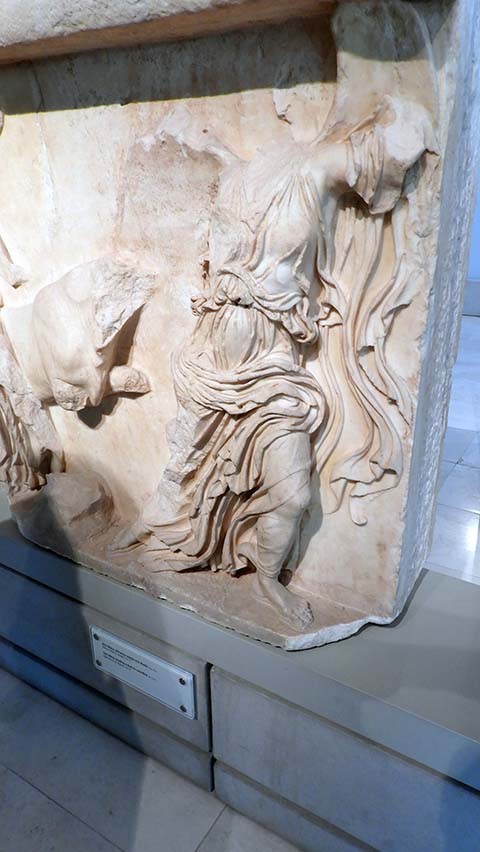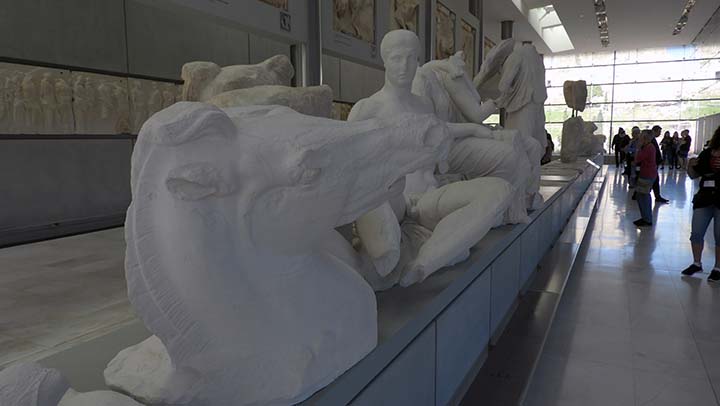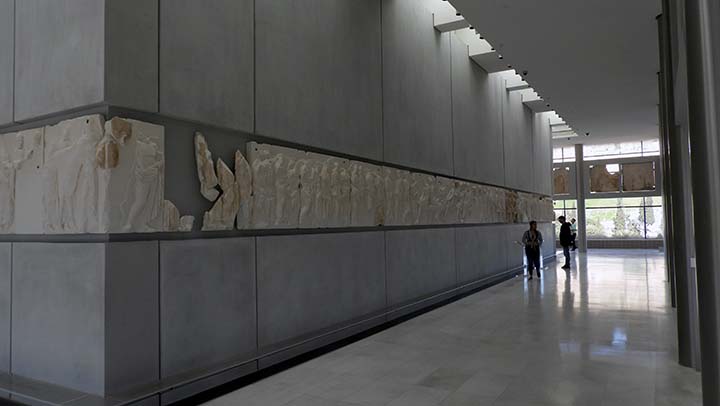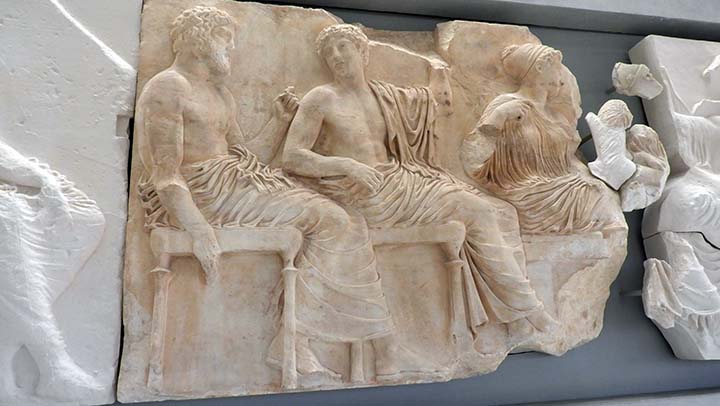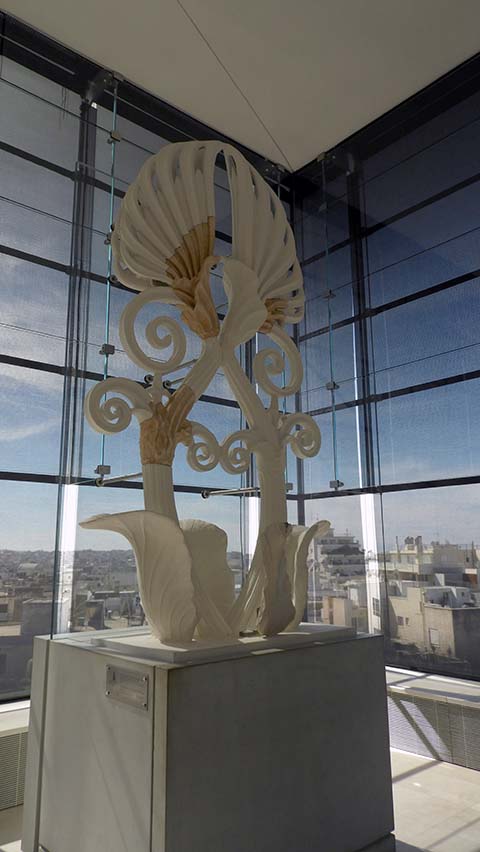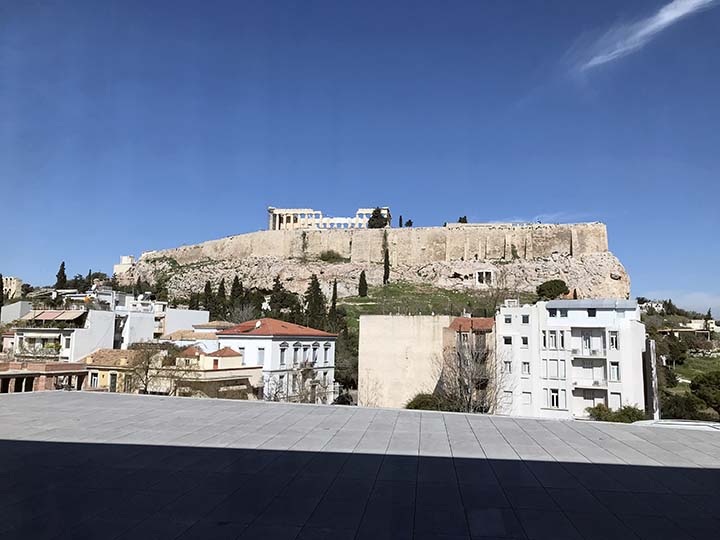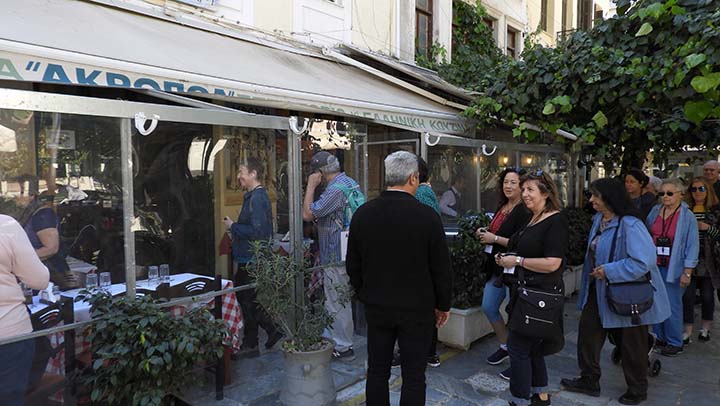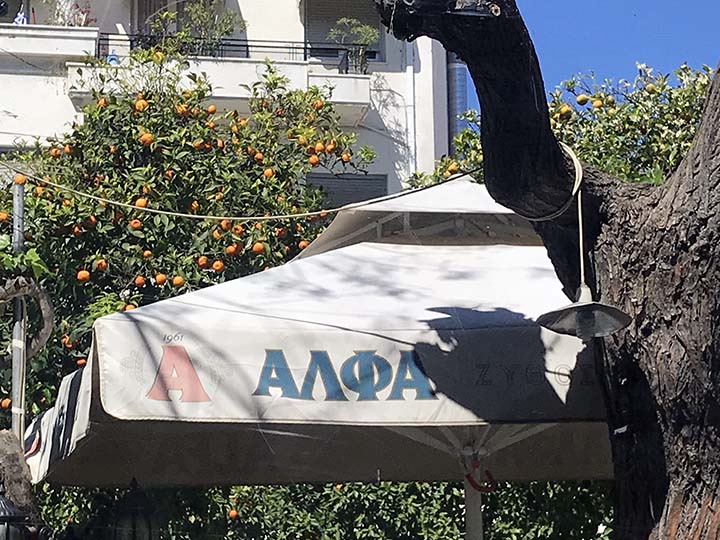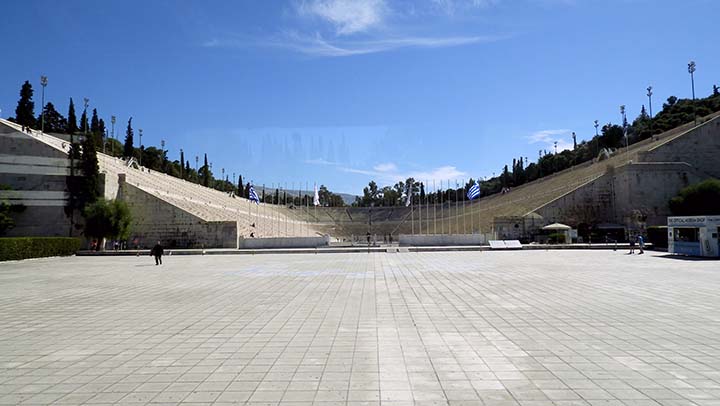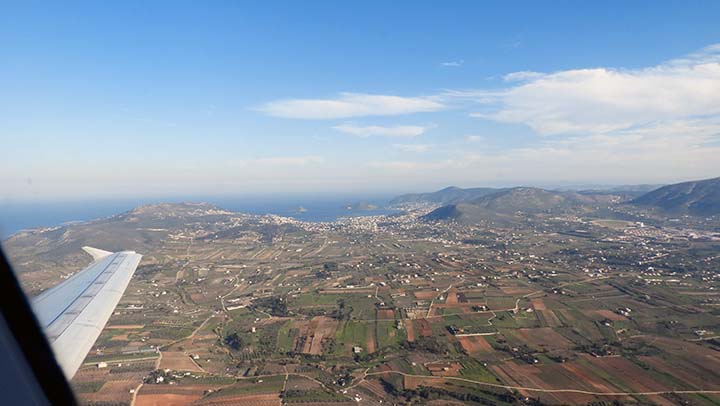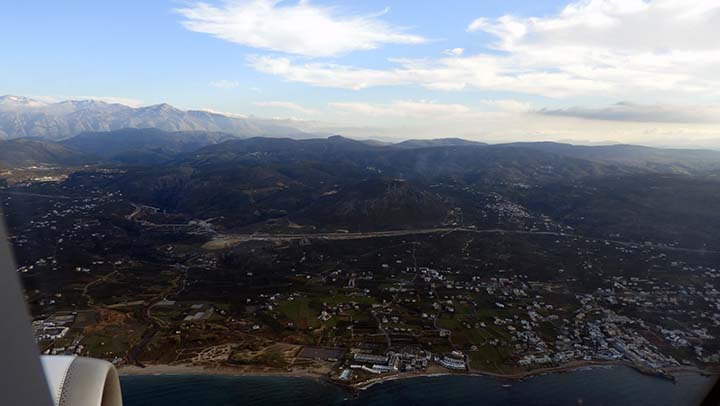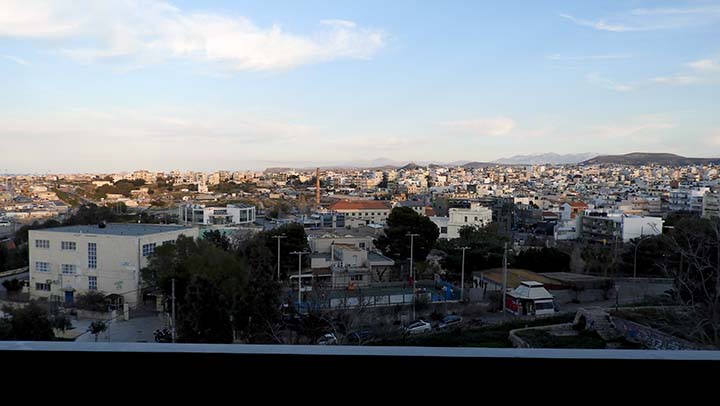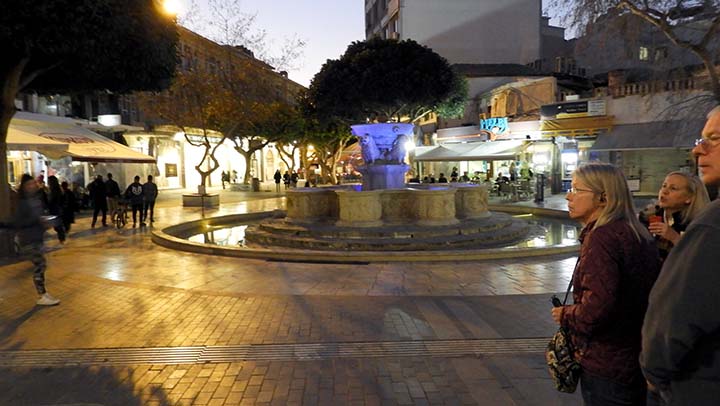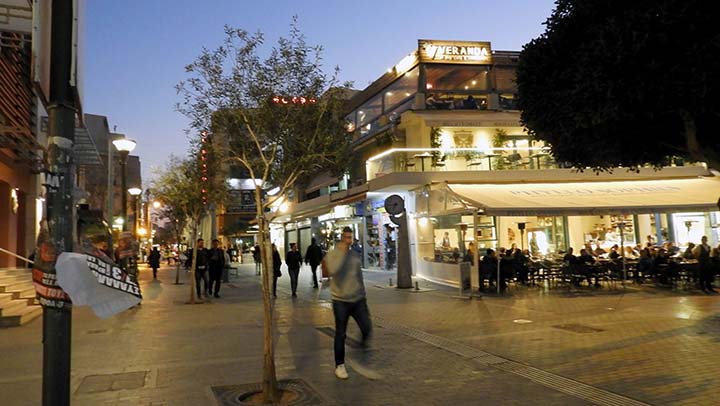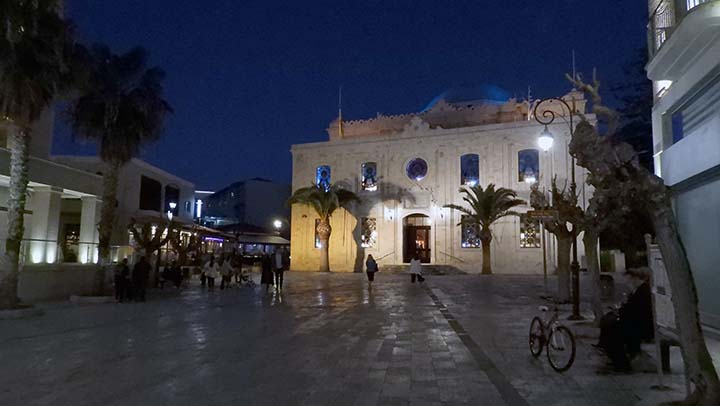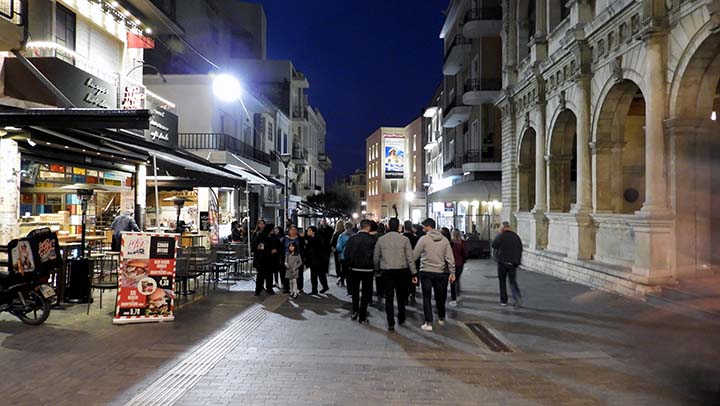|
Greece: Land of history, cradle of western democracies. I'd been all over Europe, but I've never been here before. This could be good.
The Athenian Callirhoe Exclusive Hotel was maybe a little cramped, but first class otherwise. Nice place.
Now let's get down to business: first stop, the famous Acropolis of Athens and the Parthenon.
That's it, or what's left of it. It may not be as pristine as the one in Nashville, but there is a certain magic here.
I'm about to learn that if you want to see anything in Greece, you have to be prepared to walk up something steep. Always. No exceptions.
But it's a pretty walk.
With a nice view of the city.
And it's still way up there.
OK, we agree it's pretty. Now let's see something old.
There we go...an amphitheater. Turns out it was built by the Romans, which means that in this place it's not so old at all. It's called the Odeon Herodes Atticus. We'll go down and have a look in a little while.
The Erechtheion is an ancient Greek temple on the north side of the Acropolis of Athens in Greece which was dedicated to both Athena and Poseidon.
Just look how my new camera's telephoto lens can zoom in on the place. That there is what you call your Ionic capital.
The temple has been repaired several times over the years.
But it still looks impressive over there in its spot on top of the Acropolis. The temple as seen today was built between 421 and 406 BCE. Its architect may have been Mnesicles, and it derived its name from a shrine dedicated to the legendary Greek hero Erichthonius. The sculptor and mason of the structure was Phidias, who was employed by Pericles to build both the Erechtheum and the Parthenon. Some have suggested that it may have been built in honor of the legendary king Erechtheus, who is said to have been buried nearby. Erechtheus was mentioned in Homer's Iliad as a great king and ruler of Athens during the Archaic Period, and Erechtheus and the hero Erichthonius were often syncretized. It is believed to have been a replacement for the Peisistratid temple of Athena Polias destroyed by the Persians in 480 BC.
On the north side, there is another large porch with six Ionic columns, and on the south, the famous "Porch of the Maidens", with six draped female figures (caryatids) as supporting columns. The porch was built to conceal the giant 15-ft beam needed to support the southwest corner over the Kekropion, after the building was drastically reduced in size and budget following the onset of the Peloponnesian war. In 1800 one of the caryatids and the north column of the east porch together with the overlying section of the entablature were removed by Lord Elgin in order to decorate his Scottish mansion, and were later sold to the British Museum (along with the pedimental and frieze sculpture taken from the Parthenon). The Acropolis Museum holds the other five figures, which are replaced onsite by replicas. The five originals that are in Athens are now being exhibited in the new Acropolis Museum, on a special balcony that allows visitors to view them from all sides. The pedestal for the Caryatid removed to London remains empty. Athenian legend had it that at night the remaining five Caryatids could be heard wailing for their lost sister. Elgin attempted to remove a second Caryatid and when technical difficulties arose, he tried to have it sawn to pieces. The statue was smashed, and its fragments were left behind. It was later reconstructed haphazardly with cement and iron rods. During the Greek War of Independence the building was bombarded by the Ottomans and severely damaged, the ceiling of the north porch was blown up and a large section of the lateral walls of the cella was dismantled.
The monumental gateway to the Acropolis, the Propylaea, was one of several public works commissioned by the Athenian leader Pericles in order to rebuild the Acropolis at the conclusion of the Persian Wars. Pericles appointed his friend Phidias as the supervisor and lead architect of this massive project, which Pericles allegedly financed with funds appropriated from the treasury of the Delian League. According to Plutarch, the Propylaea was designed by the architect Mnesicles, about whom nothing else is known, Construction began in 437 BC and was terminated in 432, when the building was still unfinished.
The outer (western) wings to the right and left of the central building stood on the same platform as the western portion of the central building but were much smaller, not only in plan but in scale. Like the central building, the wings use Doric colonnades and Doric entablatures. The central building also has an Ionic colonnade on either side of the central passageway between the western (outer) Doric colonnade and the gate wall. This is therefore the first building known to us with Doric and Ionic colonnades visible at the same time. It is also the first monumental building in the classical period to be more complex than a simple rectangle or cylinder. The western wing on the north (to the left as one enters the Acropolis) was famous in antiquity as the location of paintings of important Greek battles. Pausanias reports their presence, but few scholars believe the room was planned to hold them. Recent scholarship, following the lead of John Travlos (Pictorial Dictionary of Ancient Athens, New York, 1971), has taken the northern wing to have been a room for ritual dining. The evidence for that is the off-center doorway and the position near the entrance to the Acropolis. The wing on the south, though much smaller, was clearly designed to make the whole structure appear to be symmetrical. It seems only to have functioned as an access route to the Temple of Athena Nike, which stood to the south and further west, on a raised bastion.
Today the Propylaea has been partly restored, since 1984 under the direction of Tasos Tanoulas, and serves as the main entrance to the Acropolis for the many thousands of tourists who visit the area every year. In the period before the 2004 Olympic Games in Athens, the Propylaea was shrouded in scaffolding as restoration work was undertaken. At the end of 2009 all scaffolding was removed, and the building is now open fully to view again. The famous ceilings have even been partly restored. The restoration of the Central Building of the Propylaea was awarded a European Union Prize for Cultural Heritage / Europa Nostra Award in 2013.
Eleni explains it all. C'mon everybody, onward and upward and watch your step -- that marble is slippery.
View from the top. See that big rock? That's the Mars Hill you can read about in the Bible. Also known as the Areopagus, it's a prominent rock outcropping located northwest of the Acropolis. Its English name is the composite form of the Greek name Areios Pagos, translated "Ares Rock." In classical times, it functioned as the court for trying deliberate homicide. Ares was supposed to have been tried here by the gods for the murder of Poseidon's son Halirrhothius. The origin of its name is not clear. In Ancient Greek, πάγος pagos means "big piece of rock". Areios could have come from Ares or from the Erinyes, as on its foot was erected a temple dedicated to the Erinyes where murderers used to find shelter so as not to face the consequences of their actions. Later, the Romans referred to the rocky hill as "Mars Hill", after Mars, the Roman God of War. The Areopagus, like most city-state institutions, continued to function in Roman times, and it was from this location, drawing from the potential significance of the Athenian altar to the Unknown God, that the Apostle Paul is said to have delivered the famous speech, "Now what you worship as something unknown I am going to proclaim to you. The God who made the world and everything in it is the Lord of heaven and earth and does not live in temples built by hands." (Areopagus sermon, Acts 17:24)
The Temple of Hephaestus or Hephaisteion or earlier as the Theseion, is a well-preserved Greek temple; it remains standing largely as built. It is a Doric peripteral temple, and is located at the north-west side of the Agora of Athens, on top of the Agoraios Kolonos hill. From the 7th century until 1834, it served as the Greek Orthodox church of Saint George Akamates. The building's condition has been maintained due to its history of varied use. Hephaestus was the patron god of metal working, craftsmanship, and fire. There were numerous potters' workshops and metal-working shops in the vicinity of the temple, as befits the temple's honoree. Archaeological evidence suggests that there was no earlier building on the site except for a small sanctuary that was burned when the Persians occupied Athens in 480 BC. The name Theseion or Temple of Theseus was attributed to the monument under the assumption it housed the remains of the Athenian hero Theseus, brought back to the city from the island of Skyros by Kimon in 475 BC, but refuted after inscriptions from within the temple associated it firmly with Hephaestus.
But just as important as those two landmarks is the Ancient Agora of
Classical Athens. It is the best-known example of an ancient Greek
agora, located to the northwest of the Acropolis and bounded on the
south by the hill of the Areopagus and on the west by the hill known
as the Agoraios Kolonos, also called Market Hill. It's the open area
below the Temple of Hephaestus. The Agora's initial use was for a
commercial, assembly, or residential gathering place. Just about every ancient and modern city includes a place for an agora, and the Agora of Athens, being located at the heart of the city, remained in use either as an assembly, as a commercial, or as a residential area for about 5000 years. Consequently the area has undergone countless building, destruction, and rebuilding cycles. Today this strata of history has been distilled through excavations to expose the Agora's important functions from Archaic to Greco-Roman and Byzantine times.
The Parthenon is a former temple on the Athenian Acropolis, Greece, dedicated to the goddess Athena, whom the people of Athens considered their patron. Construction began in 447 BC when the Athenian Empire was at the peak of its power. It was completed in 438 BC although decoration of the building continued until 432 BC. It is the most important surviving building of Classical Greece, generally considered the zenith of the Doric order. Its decorative sculptures are considered some of the high points of Greek art. The Parthenon is regarded as an enduring symbol of Ancient Greece, Athenian democracy and western civilization and one of the world's greatest cultural monuments. To the Athenians who built it, the Parthenon and other Periclean monuments of the Acropolis, were seen fundamentally as a celebration of Hellenic victory over the Persian invaders and as a thanksgiving to the gods for that victory. The Greek Ministry of Culture is currently carrying out a program of selective restoration and reconstruction to ensure the stability of the partially ruined structure. The Parthenon itself replaced an older temple of Athena, which historians call the Pre-Parthenon or Older Parthenon, that was destroyed in the Persian invasion of 480 BC. The temple is archaeoastronomically aligned to the Hyades. Like most Greek temples, the Parthenon served a practical purpose as the city treasury. For a time, it served as the treasury of the Delian League, which later became the Athenian Empire. In the final decade of the sixth century AD, the Parthenon was converted into a Christian church dedicated to the Virgin Mary. After the Ottoman conquest, it was turned into a mosque in the early 1460s. On 26 September 1687, an Ottoman ammunition dump inside the building was ignited by Venetian bombardment. The resulting explosion severely damaged the Parthenon and its sculptures. From 1800 to 1803, Thomas Bruce, 7th Earl of Elgin removed some of the surviving sculptures with the alleged permission of the Ottoman Empire. These sculptures, now known as the Elgin Marbles or the Parthenon Marbles, were sold in 1816 to the British Museum in London, where they are now displayed. Since 1983 (on the initiative of Culture Minister Melina Mercouri), the Greek government has been committed to the return of the sculptures to Greece.
Bill the tourist is suitably impressed.
I mean, who wouldn't be?
Just look at this place! Too bad there are scaffolds everywhere, but look on the bright side: the restoration work should help this place keep looking good for another couple of thousand years.
Say, what's that over there on top of that hill? Let's give the telephoto lens a try...
Philopappos died in 116, and his death caused great grief to his sister Julia Balbilla, citizens of Athens and possibly to the imperial family. As a dedication to honor the memory of Philopappos, Balbilla with the citizens of Athens erected a tomb structure on Muse Hill (Lofos Muson) near the Acropolis of Athens. His marble tomb monument is still known as the Philopappu Monument, and the hill is today known as Philopappu Hill. So now we know what that thing was over there on a hill we could see from the Acropolis. Thanks, Wikipedia, and also thanks to my camera's fancy lens.
Pretty views everywhere you look.
Bill is exploring the art of the selfie.
That's the new Acropolis Museum down there. It's an archaeological museum focused on the findings of the archaeological site of the Acropolis. The museum was built to house every artifact found on the rock and on the surrounding slopes, from the Greek Bronze Age to Roman and Byzantine Greece. It also lies over the ruins of a part of Roman and early Byzantine Athens. The museum was founded in 2003, while the Organization of the Museum was established in 2008. It opened to the public on 20 June 2009. Nearly 4,000 objects are exhibited over an area of 14,000 square meters. We'll have a look inside in just a bit.
The Theatre of Dionysus Eleuthereus is a major theatre in Athens, built at the foot of the Athenian Acropolis. Dedicated to Dionysus, the god of plays and wine (among other things), the theatre could seat as many as 17,000 people with excellent acoustics, making it an ideal location for ancient Athens' biggest theatrical celebration, the Dionysia. It was the first theatre ever built, cut into the southern cliff face of the Acropolis, and supposedly birthplace of Greek tragedy. The remains of a restored and redesigned Roman version can still be seen at the site today. It is sometimes confused with the later, smaller, and better-preserved Odeon of Herodes Atticus, located nearby on the southwest slope of the Acropolis.
The Odeon Herodes Atticus was built in 161 AD by the Athenian magnate Herodes Atticus in memory of his wife, Aspasia Annia Regilla. It was originally a steep-sloped theater with a three-story stone front wall and a wooden roof made of expensive cedar of Lebanon timber. It was used as a venue for music concerts with a capacity of 5,000. It lasted intact until it was destroyed and left in ruins by the Heruli in 267 AD. The audience stands and the orchestra (stage) were restored using pentelic marble in the 1950s. Since then it has been the main venue of the Athens Festival, which runs from May through October each year, featuring a variety of acclaimed Greek as well as International performances.
In 1957 Maria Callas performed at the Odeon as part of the Athens Festival and in the same year Edith Hamilton was pronounced an honorary citizen of Athens at ninety years of age. In May 1962 Frank Sinatra gave two Benefit concerts for the city of Athens. The Odeon of Herodes Atticus was the venue for the Miss Universe 1973 pageant.
Ah...now for the museum.
Caryatids. See? Told you the real things were in the museum.
The classical Greek sculptors beautifully captured the flow of garments on heroic figures.
The museum was designed to have a fine view of the Acropolis.
The museum displays copies of the so-called "Elgin Marbles." The Elgin Marbles, also known pars pro toto ("a part taken for the whole") as the Parthenon Marbles, are a collection of Classical Greek marble sculptures made under the supervision of the architect and sculptor Phidias and his assistants. They were originally part of the temple of the Parthenon and other buildings on the Acropolis of Athens. In 1801, Thomas Bruce, 7th Earl of Elgin obtained a firman, which was an official decree, from the Sublime Porte, the central government of the Ottoman Empire which were then the rulers of Greece. Elgin was also later approved by a second firman which allowed for the shipping of the marbles from the Piraeus. From 1801 to 1812, the Earl's agents removed about half of the surviving sculptures of the Parthenon, as well as sculptures from the Propylaea and Erechtheum. The Marbles were transported by sea to Britain. In Britain, the acquisition of the collection was supported by some, while some others, such as Lord Byron, likened the Earl's actions to vandalism or looting. Following a public debate in Parliament and the subsequent exoneration of Elgin, he sold the Marbles to the British government in 1816. They were then passed to the British Museum, where they are now on display in the purpose-built Duveen Gallery. After gaining its independence from the Ottoman Empire in 1832, Greece began a series of projects to restore its monuments. It has expressed its disapproval of Elgin's removal of the Marbles from the Acropolis and the Parthenon, which is regarded as one of the world's greatest cultural monuments. Greece continues to urge the return of the marbles to Greece for their unification by diplomatic and political means.
Bill was impressed by how the museum displays the frieze that once surrounded the Parthenon. This inner wall of the museum is part of a rectangle that allows the frieze to be displayed as it once was on the Parthenon.
Some original, some reproduction.
And all beautiful.
Bye, Acropolis.
It's lunchtime and we're hungry.
Eleni is taking us to a terrific restaurant in a local garden area.
Moussaka. Well, of course. If you're going to visit Greece, you gotta expect to have some moussaka. Mmmmm.
I told you this was a garden area. Just look at those orange trees outside. And smell those orange blossoms!
Now we're driving to the airport and we're passing the Marathon Stadium. The Panathenaic Stadium or Kallimarmaro (lit. "beautiful marble") is a multi-purpose stadium in Athens, Greece. One of the main historic attractions of Athens, it is the only stadium in the world built entirely of marble. A stadium was built on the site of a simple racecourse by the Athenian statesman Lykourgos (Lycurgus) c. 330 BC, primarily for the Panathenaic Games. It was rebuilt in marble by Herodes Atticus, an Athenian Roman senator, by 144 AD and had a capacity of 50,000 seats. After the rise of Christianity in the 4th century it was largely abandoned. The stadium was excavated in 1869 and hosted the Zappas Olympics in 1870 and 1875. After being refurbished, it hosted the opening and closing ceremonies of the first modern Olympics in 1896 and was the venue for 4 of the 9 contested sports. It was used for various purposes in the 20th century and was once again used as an Olympic venue in 2004. It is the finishing point for the annual Athens Classic Marathon. It is also the last venue in Greece from where the Olympic flame handover ceremony to the host nation takes place.
We're on our way to Crete! Bye, Athens.
Hi, Crete!
Boarding our transportation for the next week.
Our hotel in Heraklion is quite nice. Seriously nice.
Nice view from Bill's room.
Nice digs.
Eleni is taking us on an evening stroll around the neighborhood. What a pretty fountain!
It's Sunday night and not many shops are open.
Street vendors are out in full force, though. Peanuts and corn on the cob. Mmmmm. Be strong, Bill.
Greeks love to be out in the evening air, dining, shopping, strolling, enjoying life.
And what could be more enjoyable than GELATO!! No, Bill, not tonight.
Eleni claimed that shop with the natural wood doors has the best bugatsa in all of Greece. And then she kept feeding Bill so much food every day he never felt hungry enough to come back here and try some. Bill will have to go back to Heraklion someday. Oh, what's bugatsa, you ask? It's a Greek breakfast pastry consisting of either semolina custard, cheese, or minced meat filling between layers of phyllo. But don't despair; Bill will find some eventually. You'll see.
It's getting late and everybody is tired.
Yes, there are still interesting things to look at, but c'mon.
It's been a big day. Let's go back to the hotel.
|

